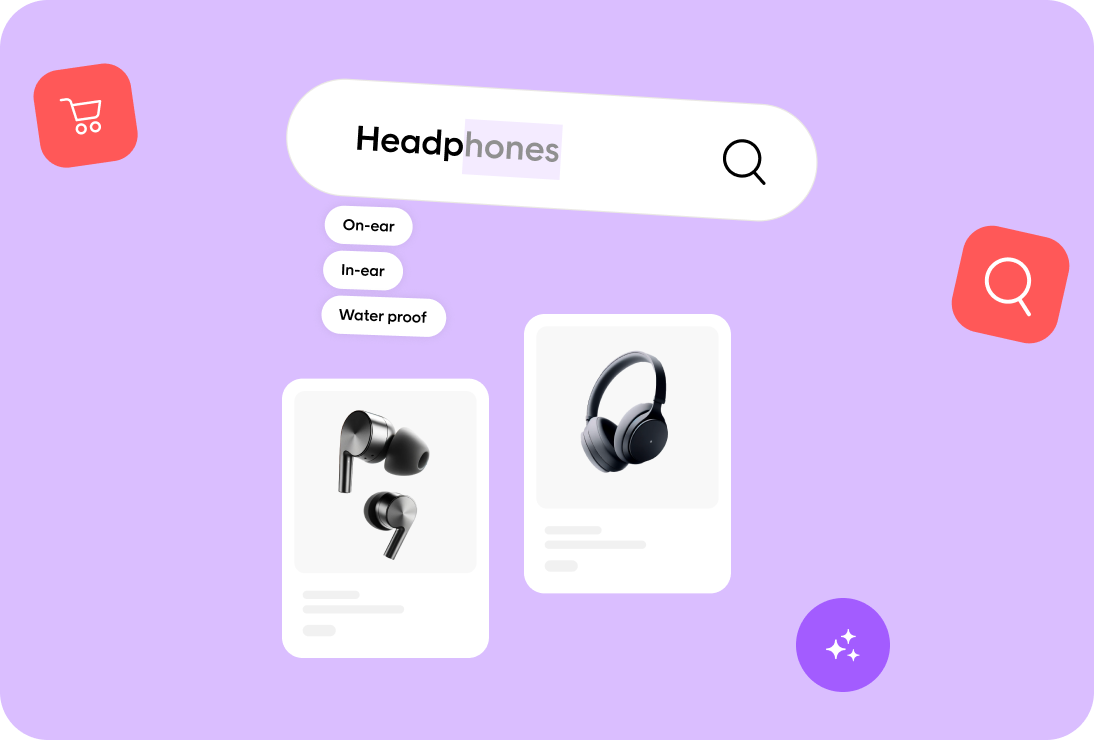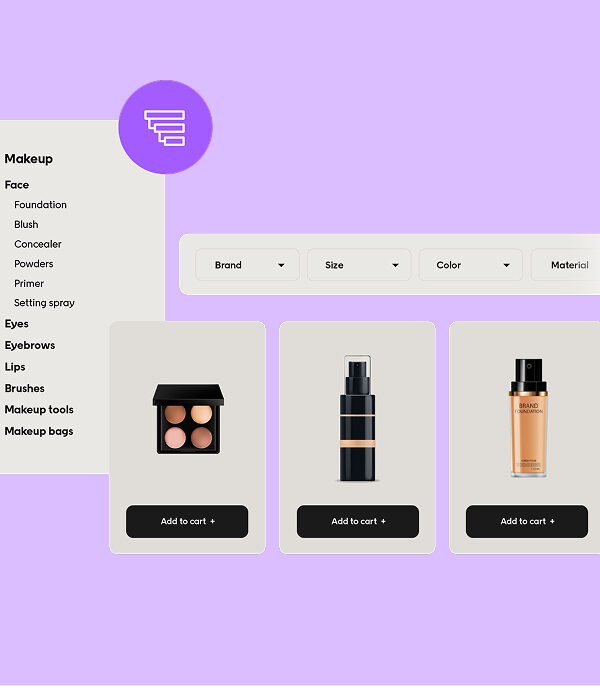TL;DR
- Site search tells you what your customers really want
- Better search leads to higher conversions and fewer drop-offs
- Search analytics reveal hidden trends and popular products
- Poor results frustrate users and raise support costs
- A strong search experience builds loyalty and long-term growth
Site search is your customer’s voice
When a shopper types something into your search bar, they’re telling you exactly what they want. Every word is an insight into intent. Yet too often, search gets overlooked.
The result? Frustrated users who leave before finding what they came for.
If your business treats site search as a key part of the customer journey, everything changes.
A smart search engine guides your visitors to the right products, reduces friction, and helps your team spot what’s missing from your site. It’s one of the easiest ways to improve your online shopping experience and drive steady growth.
Voyado’s Retail Radar 2025 shows that shoppers across Europe expect convenience, relevance, and speed.
In the Nordics, in-store sales grew by nearly 12% in 2024, while online performance slowed.
That’s a clear signal that your digital experience needs to work harder to engage and convert. And a well-optimized site search is one of the best places to start.
Let’s look at what site search really means for your business and why it’s worth investing in.
What is site search and why it’s worth investing in
A strong site search does more than help visitors find products. It connects what people want with what your business offers.
What site search really does
Site search is the tool that helps your website visitors find content or products using their own words. It uses a built-in search engine to read every query, match it against your website’s content, and deliver relevant results.
A good search experience feels almost invisible. Customers type, results appear, and the right products surface fast. When it works, shoppers stay longer, buy more, and trust your brand to understand their needs.
Why your search bar deserves attention
Many teams invest heavily in ads or email campaigns but forget about the search function on their website. That’s a missed opportunity. The search bar is one of the few places where your customers openly tell you what they want to see next.
Every query adds to your understanding of:
- What your customers can’t find
- Which products or pages drive the most interest
- Where content gaps exist in your product range or service pages
These insights can shape everything from product naming to campaign planning.
What the Retail Radar tells us
Voyado’s Retail Radar 2025 shows exactly why optimizing your search experience matters. Across the Nordics, total retail revenue increased by 7.4% last year, but online sales dropped by 3.7%. The report highlights that customers now expect relevance, personalization, and convenience when shopping online.
In Germany, the same trend appears: personalization is no longer a luxury, it’s an expectation. Retailers that harness their own customer insights gain a clear competitive edge.
Site search is one of the easiest ways to meet those expectations. When your customers can find what they want quickly, they stay longer, buy more, and come back again.
A small change, a big impact
A well-designed search tool improves user satisfaction, reduces bounce rates, and increases conversion rates.
It also helps your customer service team by reducing the number of “I can’t find this product” requests, lowering support costs while improving the overall experience.
You don’t need a full website rebuild to see results. Improving search is one of the easiest and most measurable upgrades your e-commerce team can make.
The business impact of a good search experience
Site search isn’t just a technical feature. It’s a direct line between your customers’ intent and your revenue. When your search function performs well, everything else in your e-commerce ecosystem benefits.
Turn search insights into revenue
Every search query is a data point. When analyzed, those queries show what people are actively trying to buy. This is where site search analytics come in. They reveal which products get the most attention, which pages convert best, and where your visitors drop off.
With the right site search analysis, you can:
- See which keywords drive sales
- Spot trends before they show up in your reports
- Find gaps in your website’s content
- Align your product range with customer demand
We’ve seen that fashion and beauty now lead revenue growth across the Nordics, driven by convenience and personalized shopping experiences. That same insight applies to your search data. When your products are easy to find, your revenue follows.
Real-world proof: Obs and Obs Bygg
A great example comes from Obs and Obs Bygg, part of Coop Norway. As they expanded online, their goal was to replicate the in-store experience where staff could instantly recommend the right products.
When introducing Voyado Elevate, Obs, and Obs Bygg combined offline transaction data with real-time online behavior.
This was the result:
“By leveraging Voyado Elevate’s product intelligence in our search, we observed improved customer experience and significantly better numbers: a 4.5% increase in revenue from search.” – Øyvind Moen, eCommerce Product Manager at Coop
Their merchandiser team also gained new agility. With easy-to-use editorial tools, they cut time to market for site updates and campaigns, giving them full control over search and recommendations without needing technical support.
This mix of data, automation, and empowerment shows what’s possible when you treat site search as a growth engine, not just a feature.
Better search means happier customers
A strong search function helps your website visitors find relevant content fast. This improves user satisfaction and makes their online shopping experience feel smooth and personal.
Good search results also reduce frustration. When customers see relevant results instead of “no results found,” they’re more likely to stay, explore, and buy.
Reduce effort and support costs
If your customers can find what they’re looking for, they don’t need to contact your support team. That means fewer tickets and faster service. By improving your search tool, you’re giving your team back valuable time.
For your business, this adds up to lower support costs, better conversion rates, and higher customer lifetime value.
What your site search data can tell you
Your search bar collects more data than you might realize. Every word your customers type is a clue about what they need, what’s missing, and how well your content is performing.
Get to know your search users
Site search analytics show how visitors behave on your site. You can see which search queries are most common, which pages lead to conversions, and where users give up.
For example, if a product gets hundreds of searches but few clicks, the issue isn’t demand. It’s visibility. Your site might need clearer descriptions or better categorization.
Spot hidden trends and content gaps
Site search analysis can reveal what your customers want before your competitors notice. That includes:
- Popular queries that don’t match any existing page
- Terms that signal new interests or product ideas
- Repeated “no results” searches that highlight content gaps
These insights help your team create more relevant content and improve your product range.
Use the data to shape smarter campaigns
When you know what people search for, you can adjust your messaging, refine your market segmentation, and make your offers more personal.
For example:
- If many visitors search for “vegan skincare,” promote those products in your newsletters.
- If “gift ideas” spikes before holidays, tailor homepage banners and product bundles to match.
From analysis to action
Understanding search users helps your business move beyond assumptions. It gives your marketing, product, and service teams a clear view of real demand. Traditional analytics rarely offer this level of insight.
It’s data that is easily accessible and worth investing in.
How to optimize your site search
Improving your site search doesn’t have to be complicated. Start with small changes that make it easier for your customers to find what they want and for your team to understand what’s working.
Make your search function easy to use
Your search bar should be visible on every page, with a simple design that invites visitors to use it. Add helpful features such as:
- Autocomplete suggestions to guide users quickly to relevant results
- Synonym matching so “trainers” and “sneakers” lead to the same products
- Faceted search filters that let shoppers narrow results by size, color, or price
- Search relaxation expands the search to show more results when the query gets too specific for a match
The easier your search tool is to use, the more data you’ll collect and the more confident your customers will feel while browsing.
Improve your indexing and metadata
Behind the scenes, your search engine relies on well-structured, high-quality data. Make sure your product descriptions, tags, and categories are clear and consistent so your content can be properly indexed and easily found.
Great search starts with great data. Most engines use keyword matching, which works when shoppers type the exact words in your listings. But customers don’t always search that way.
That’s where semantic search comes in. It understands meaning and context, not just words.
Here’s how they differ:
- Keyword search: Matches exact terms from your listings.
- Semantic search: Understands intent, context, and related concepts.
For example, a search for “cozy winter jacket” can also surface “puffer coat” or “insulated parka.”
To deliver that kind of accuracy, combine both approaches. A search engine powered by AI and product intelligence connects keywords with meaning, enriching your product data and uncovering relationships between items. The result is a search that feels human, relevant, and intuitive.
When shoppers feel understood, they find what they need faster, and your business gains clearer insights into what drives intent.
Keep your index clean and complete:
- Review which pages are currently indexed.
- Use tools like Google Analytics to spot high-traffic queries with low conversions.
- Refresh metadata and improve your Google index coverage when key pages don’t appear in results.
Focus on relevance, not just results
Good search isn’t about showing everything. It’s about showing the right things. Train your search tool to prioritize relevance so users see their desired products first.
That means refining how results are ranked, adding filters for popular queries, and reviewing “no results” pages regularly. When visitors find what they need on the first try, they’re far more likely to stay, explore, and convert.
Learn from your competitors
Your competitor’s site can be a valuable learning tool. Analyze how their search function works, what filters they use, and how they display results. Then test similar improvements on your own site and measure how your visitors respond.
Small, data-driven updates can have a big impact on conversion rates, relevance, and overall satisfaction.
How Voyado helps retailers unlock the full potential of site search
You already know how powerful site search can be. But most retailers only scratch the surface. The real value comes when your team connects what customers search for with what they actually buy. That’s where Voyado Elevate comes in.
Turn every search into an opportunity
Voyado Elevate helps you go beyond basic keyword matching. It uses smart product intelligence to understand what your customers mean, not just what they type.
That means your shoppers see the most relevant products instantly, even when they use different words or spellings.
This kind of insight-driven search helps your business:
- Match products to intent in real time
- Improve product discovery across your full range
- Deliver more personal and relevant experiences
- Increase conversions while reducing friction
Make product discovery smarter
Your customers expect your search to feel intuitive and personal. With Voyado Site Search, your team can create that experience automatically. The system learns from every query, measuring and improving relevance with each visit.
As a result, your website becomes easier to navigate, your products get more visibility, and your shoppers find what they want faster. That means more satisfied customers and stronger long-term growth.
Built for modern retail teams
Voyado’s AI-powered search capabilities are designed for busy e-commerce teams that want results fast. You don’t need to overhaul your tech stack or start from scratch.
You simply get better insights, more control, and a search experience that feels effortless – for you and for your customers.
Final thoughts: Make site search your silent sales driver
Your site search is more than a navigation tool. It’s how your customers tell you what they want, in real time. When you listen, analyze, and act on that data, you can turn every visit into a new opportunity for engagement and growth.
Strong site search improves user satisfaction, increases conversion rates, and helps your teams spend less time solving “I can’t find it” tickets. It’s a simple shift that delivers measurable impact across your business.
What to do next
- Audit your current search results and “no results” pages
- Review your indexing and check for missing or outdated content
- Explore how AI-driven product discovery can improve relevance and speed
- Set up reporting for site search analytics to track progress
- Partner with a platform that understands retail inside and out
If you’re ready to turn your search bar into a sales engine, book a demo with Voyado and see how smarter product discovery can transform your customer experience.
FAQs
What is site search analytics?
Site search analytics track how users interact with your search bar. They show which queries are popular, which pages get clicks, and where users drop off. These insights help your team spot content gaps and improve the overall shopping experience.
How can I improve my e-commerce’s search function?
Start by making your search bar visible on every page and easy to use. Add autocomplete, filters, and synonym matching. Then review your metadata and make sure your most important products are properly indexed.
Why do “no results” pages hurt conversions?
When visitors can’t find what they’re looking for, they leave. Reviewing your “no results” data helps you identify missing products or poor keywords so you can fix issues before they cost you more sales.
What is faceted search?
Faceted search lets users filter results by category, size, price, or color. It’s one of the best ways to make your site search feel faster and more personal, especially for customers browsing large product ranges.
How can site search data reduce support costs?
If customers can find answers or products on their own, they don’t need to contact your support team. That saves time and money while improving user satisfaction.










